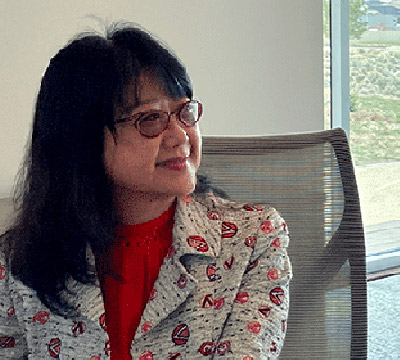Driving the Climate Change Conversation: The BMO Climate Institute
It’s been a year since BMO declared its Net-Zero Ambition, pledging to reach net zero by 2050. This ambition included the launch of the BMO Climate Institute, to bridge climate policy and science with business strategy and finance. In the past 12 months, the Institute has worked to provide a platform for thought leadership and collaboration with industry, government, academia and investors to help advance climate solutions and identify opportunities for clients.
“Addressing climate change requires navigating a complex system, and one of the roles of the Climate Institute is to provide the resources our BMO teams need to accelerate understanding of the challenges their clients are facing, and also the opportunities in the economic transformation,” said Climate Institute Head Susan McGeachie.
Following is an interview with Susan and Michael Torrance, BMO’s Chief Sustainability Officer, on how the climate change panorama has evolved even since the Climate Institute was launched in March 2021. Our experts discuss what has happened over the past year, how they view the future, and how the bank and the Climate Institute are working to not just navigate a world transitioning to a low carbon future, but to identify opportunities for the bank and its clients.
The Climate Institute launched a year ago. Looking back, how do you feel about where we are today? What were your expectations going in and, after a year, where are we on that journey?
Michael: We’ve accomplished a lot in one year and our momentum is building. As a bank, as providers of capital to the entire economy, we see ourselves as critical enablers of the net-zero transition and I can say that today we have a clear focus on how we can bring our whole-bank expertise to partner with our clients in the transition to net zero.
The Climate Institute has already had a real impact, engaging and advancing thought leadership with government, industry initiatives and building awareness of climate opportunities with our business leaders. We are also building bridges internally to make sure our climate focus in many areas of the bank is greater than the sum of its parts. A good early example was the launch of our Climate Essentials training course, a collaboration between the Institute and the BMO Sustainability Office that helps to educate us all on the impacts of climate change on our environment, and how BMO is working to mitigate climate change. We will continue to build on the course and to level set within the organization on the topic of climate as our role in the transition to a net zero world evolves.
What were the main challenges for the Institute this year and what are the main challenges for the coming year? Have you had any unexpected learnings in this year?
Susan: Addressing climate change requires navigating a complex system, and one of the roles of the Climate Institute is to provide the resources our BMO teams need to accelerate understanding of the challenges their clients are facing, and also the opportunities in the economic transformation. We are a multidisciplinary team of climate experts that have deep expertise in this area, and we are bringing these resources to our bankers so that they can navigate all those different levels of understanding and be able to point their clients into areas they may not have thought of before.
A key pillar of the Institute is to convene and align stakeholders to enable climate solutions and ensure that the systems are in place to enable us to achieve our net-zero ambition. We achieve that by being a part of, and drivers of, the right conversations, whether through our White Papers – like the recently published Decarbonizing Canada’s Housing Market – our panels – like the one we ran at BMO’s recently Global Metals and Mining Conference on Mining’s Megawatt Future – or our sponsorship and participation on industry initiatives, like Electrifying Canada, which is a business-led task force to accelerate electrification across Canada and help it reach net zero by 2050.
One of the main tenets of the Climate Institute is to help BMO be its clients’ lead partner in the transition to a low carbon future. What is the opportunity set for clients?
Susan: One opportunity is for clients to interact directly with the Climate Institute to address specific challenges to see how the bank can help. For example, they need financing support for decarbonization but can’t take on any more debt – how can the bank help? The Climate Institute can navigate this type of challenge within the bank’s complex structure to see if we can help create a solution.
We as a bank have an economy-wide perspective and so approach climate change through the lens of themes that affect multiple industries. We’re looking at how businesses will function in this transition to new ways of producing and consuming energy. We bring that perspective to all of our collaborative initiatives, for example in the Climate Institute’s support of Electrifying Canada, an industry-led initiative analyzing how, in the drive to net zero by 2050, we can move to electrify large portions of Canada’s transport, buildings and industry, and ensure the power sector is equipped to support that transition.
The Climate Institute is pioneering the use of some very interesting technologies with respect to applying a financial lens to physical climate risk, what can you say about progress in this area? Do you see spatial finance becoming a mainstream industry offering?
Michael: Climate and its effects on physical assets are complex, and we’ve been fortunate to be early adopters of tools that leverage big data and geospatial modelling that help us to understand these topics. These can be platforms to help advise clients and generate our own internal insights on climate risks and opportunities to build resilience and adaptation.
We are especially proud of our geospatial platform, which we developed in collaboration with BMO Enterprise Data Science & AI team (Data and Analytics) and Climate Engine, an external partner. The platform can analyze over 80 climate-related risk drivers and outcomes, from temperature, precipitation and flooding to wildfires, wind, drought, crop health, soil moisture and a lot more.
Spatial finance can take the understanding of physical climate risk to the next level of integrating these insights into our work as a bank. We’re in an exploratory stage at this point but actively thinking about how to deploy these capabilities, especially to support our clients in sectors ranging from mining to agriculture and real estate.
The Climate Institute recently published a White Paper on Decarbonizing Residential Real Estate. Why was this such an important topic to delve into and what were the main findings of the report?
Susan: It’s a live example of the need to convene different actors to make a Net Zero economy possible. We decided to develop this white paper [LINK] as we were thinking through how to set targets to reduce emissions associated with our residential and commercial portfolios. We realized that we don’t have influence over so much of what must happen to make scale decarbonization in Canadian real estate possible. So, this paper was designed to spark a conversation about the need to increase Canada’s clean energy supply and accelerate electrification technologies. Some of that the bank can influence, but a lot of it comes down to government policies to support a clean grid, increase the supply of clean electricity, reduce the carbon intensity of natural gas, and enable banks to access data on the carbon intensity of individual buildings. We have an important role to play in financing the transition, but we can only play it when all other enabling factors are in place.
Let’s move to the Climate Change panorama in general. In the wake of COP26 in Glasgow, what are the main accomplishments of the past year and what are some of the key challenges going forward?
Susan: One of the main accomplishments of the past year has been ensuring that there will be a flow of capital to the transition and the Road to Net Zero, and there are a number of examples of that. The Glasgow Financial Alliance for Net Zero (GFANZ), which is a global coalition of 500 companies worth $130 trillion, committing to the decarbonization of the global economy, is a very good start. It has everybody’s attention. Another example is the Net Zero Banking Alliance. We are signatories of both. Also of note is the First Movers’ Coalition led by John Kerry, which came out of COP26. This coalition is a commitment from companies to purchase low- and zero-emission technologies to help accelerate scale, and it makes the private sector an integral pillar of the global strategy to reach net zero. What we would like to do at the Climate Institute, going forward, is to find ways to bring our small and medium-sized clients along on this journey too, which will be a challenge, but also an exciting opportunity.
Is the world on the right track to get to Net Zero by 2050? What are you optimistic about?
Susan: Not quite yet. We need a lot more work and we’re going to need many more in-depth conversations to get this right. Entire systems must be unravelled and rebuilt, and to do that, we need to figure out what we’re rebuilding to. This will take collaboration and learning; it’s going to take a lot of people coming up to speed on technologies and climate science to rethink their business models to align with their industry’s net-zero pathway.
I’m optimistic, however, because I have never seen the conversation as aligned as it is today. I’ve been working in the climate change and sustainability field for 22 years now and I’ve never seen it where it is today. Paris was unprecedented in the number of countries that signed on. COP26 saw all those countries come together to actively participate in the development of solutions and acknowledge accountability to the people they were there to represent. We have got more serious momentum than we have ever had before.
Coming back to BMO, Sustainability, and the bank’s Net Zero 2050 ambition, how optimistic are you about the steps the bank has put in place?
Michael: I’m very optimistic that we are among the most sophisticated and forward-thinking banks in the world on this topic. Our global leadership is evident, and I’m constantly being told by people I speak with that BMO is clearly a leader in this space. This doesn’t just mean that we get the issue, though we do, it also means we’re in a leading position when it comes to capturing opportunities that will flow from this megatrend of climate transition and adaptation. Our work is just getting started to further embed this thinking into everything we do, but we’ve made enormous progress and have created a strong foundation on which to build.
What lies ahead for bank sustainability in the next year?
Michael: We will continue to drive forward in our work, supporting the bank’s Purpose, enhancing our climate and net zero work, building out with our Risk partners our approach to environmental and social risk management, continue to grow our internal engagement and networks, further establish the Climate Institute as a leadership hub within the bank and externally, and support the advancement of our sustainable finance strategy, including by improving our ability to track and monitor sustainable finance with better technology and data capabilities. Beyond climate we are also focused on topics like human rights, and we are working closely to develop new approaches for sustainable procurement, including a focus on the circular economy.








